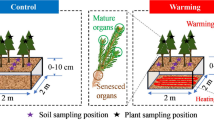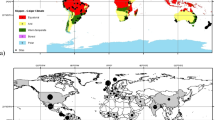Summary
Gas exchange patterns and nocturnal acid accumulation were examined in four species of Clusia under simulated field conditions in the laboratory. Clusia alata and C. major had midday stomatal closure, substantial net CO2 exchange (\(J_{CO_2 }\)) during the night, and the highest water use efficiency (WUE). C. venosa showed a pattern similar to a C3 plant, with nighttime stomatal closure, while C. minor maintained positive \(J_{CO_2 }\) continuously throughout a 24-h period. However, large changes in titratable acidity, which closely matched changes in citrate and malate levels, indicated that Crassulacean acid metabolism (CAM) is active in all four species. C. venosa showed dawn-dusk oscillations in titratable acidity that were higher than the values reported for other C3-CAM intermediates, while the nighttime acid accumulation of 998 mol m−3 observed in C. major is unsurpassed by any other CAM plant. Moreover, the dawn-dusk changes in citrate levels of over 65 mol m−3 in C. alata and C. minor, and over 120 mol m−3 in C. major, are 3–6 times higher than values reported for other CAM plants. Although these oscillations in citrate levels were quite large, and the nighttime dark respiration rates were high, the O2 budget analysis suggestes that only part of the reducing power generated by the synthesis of citric acid enters the respiratory chain. Dawn-dusk changes in malate levels were just over 50 mol m−3 for C. venosa but over 300 mol m−3 for C. major. Between 28% (C. major) and 89% (C. venosa) of the malate accumulated during the night was derived from recycled respiratory CO2. These daily changes in malate and citrate levels also contributed significantly to changes in leaf sap osmolality. This variability in CO2 uptake patterns, the recycling of nighttime respiratory CO2, and the high WUE may have contributed to the successful invasion of Clusia into a wide range of habitats in the tropics.
Similar content being viewed by others
References
Borland AM, Griffiths H (1989) The regulation of citric acid accumulation and carbon recycling during CAM in Ananas comosus. J Exp Bot 40:53–60
Fetene M, Lee HSJ, Lüttge U (1990) Photosynthetic acclimation in a terrestrial CAM bromeliad, Bromelia humilis Jacq. New Phytol 114:399–406
Griffiths H (1988) Carbon balance during CAM: an assessment of respiratory CO2 recycling in the epiphytic bromeliads Aechmea nudicaulis and Aechmea fendleri. Plant Cell Environ 11:603–611
Griffiths H (1989) Carbon dioxide concentrating mechanisms and the evolution of CAM in vascular epiphytes. In: Lüttge U (ed) Vascular plants as epiphytes: evolution and ecophysiology. (Ecological Studies, vol 76) Springer Berlin, pp 42–86
Griffiths H, Lüttge U, Stimmel K-H, Crook CE, Griffiths NM, Smith JAC (1986) Comparative ecophysiology of CAM and C3 bromeliads. III. Environmental influences on CO2 assimilation and transpiration. Plant Cell Environ 9:385–393
Griffiths H, Ong BL, Avadhani PN, Goh CJ (1989) Recycling of respiratory CO2 during Crassulacean acid metabolism: alleviation of photoinhibition in Pyrrosia piloselloides. Planta 179:115–122
Guralnick LJ, Rorabaugh PA, Hascom Z III (1984) Influence of photoperiod and leaf age on crassulacean acid metabolism in Portulacaria afra (L.) Jacq. Plant Physiol 75:454–457
Hohorst HJ (1965) l-(−)-Malate. Determination with malic acid dehydrogenase and DPN. In: Bergmeyer HU (ed) Methods of enzymatic analysis. Academic Press, New York, pp 328–332
Larcher W (1980) Physiological plant ecology, 2nd ed. Springer, Berlin
Lee HSJ, Schmitt AK, Lüttge U (1989) The response of the C3-CAM tree Clusia rosea to light and water stress. II. Internal CO2 concentration and water use efficiency. J Exp Bot 40:171–179
Lüttge U (1987) Carbon dioxide and water demand: Crassulacean acid metabolism (CAM), a versatile ecological adaptation exemplifying the need for integration in ecophysiological work. New Phytol 106:593–629
Lüttge U (1988) Day-night changes of citric acid levels in crassulacean acid metabolism: phenomenon and ecological significance. Plant Cell Environ 11:445–451
Lüttge U, Ball E (1987) Dark respiration of CAM plants. Plant Physiol Biochem 25:3–10
Lüttge U, Smith JAC, Marigo G (1982) Membrane transport, osmoregulation, and the control of CAM. In: Ting IP, Gibbs M (eds) Crassulacean acid metabolism. American Society of Plant Physiologists., Rockville, Maryland, pp 69–91
Lüttge U, Stimmel K-H, Smith JAC, Griffiths H (1986) Comparative ecophysiology of CAM and C3 bromeliads. II. Field measurements of gas exchange of CAM bromeliads in the humid tropics. Plant Cell Environ 9:377–383
Medina E (1982) Temperature and humidity effects on dark CO2 fixation by Kalanchoe pinnata. Z Pflanzenphysiol 107:251–258
Möllering H (1985) Citrate. Determination with citrate lyase, MDH and LDH. In: Bergmeier HU (ed) Methods of enzymatic analysis 3rd ed., vol. VII. Academic Press, New York, pp 2–12
Nobel PS (1988) Environmental biology of agaves and cacti. Cambridge University Press, New York
Nobel PS, Hartsock TL (1986) Leaf and stem CO2 uptake in the three subfamilies of the Cactaceae. Plant Physiol 80:913–917
Nobel PS, McDaniel RG (1988) Low temperatures tolerances, nocturnal acid accumulation and biomass increases for seven species of agave. J Arid Environ 15:147–155
Popp M, Kramer D, Lee H, Diaz M, Ziegler H, Lüttge U (1987) Crassulacean acid metabolism in tropical dicotyledonous trees of the genus Clusia. Trees 1:238–247
Rayder L, Ting IP (1981) Carbon metabolism in two species of Pereskia (Cactaceae). Plant Physiol 68:139–142
Ritz D, Kluge M (1987) Circadian rhythmicity of CAM in continuous light: Coincidences between gas exchange parameters, 14CO2 fixation patterns and PEP-carboxylase properties. J Plant Physiol 131:285–296
Schmitt AK, Lee HSJ, Lüttge U (1988) The response of the C3-CAM tree Clusia rosea to light and water stress. I. Gas exchange characteristics. J Exp Bot 39:1581–1590
Sestak Z, Catsky J, Jarvis PG (1971) Plant photosynthetic production: Manual of methods. Dr W. Junk, The Hague
Sims DA, Pearcy RW (1989) Photosynthetic characteristics of a tropical understory herb, Alocasia macrorrhiza, and a related crop species, Colocasia esculenta, grown in contrasting light environments. Oecologia 79:53–59
Smith JAC, Griffiths H, Lüttge U, Crook CE, Griffiths NM, Stimmel K-H (1986) Comparative ecophysiology of CAM and C3 bromeliads. IV. Plant water relations. Plant Cell Environ 9:395–410
Sternberg L da SL, Ting IP, Price D, Hann J (1987) Photosynthesis in epiphytic and rooted Clusia rosea Jacq. Oecologia 72:475–460
Ting IP, Lord EM, Sternberg L da SL, DeNiro MJ (1985) Crassulacean acid metabolism in the strangler Clusia rosea Jacq. Science 229:969–971
Ting IP, Hann J, Holbrook NM, Putz FE, Sternberg L da SL, Price D, Goldstein G (1987) Photosynthesis in hemiepiphytic species Clusia and Ficus. Oecologia 74:339–346
Tinoco Ojanguren C, Vasquez-Yanes C (1983) Especies CAM en la selva humeda tropical de los Tuxtlas, Vera Cruz. Bol Soc Bot Mexico 45:150–153
Willert DJ von, Thomas DA, Lobin W, Curdts E (1977) Ecophysiologic investigations in the family of the Mesembryanthemaceae. Occurrence of a CAM and ion content. Oecologia 29:67–76
Willis JC (1973) A dictionary of the flowering plants and ferns. Cambridge University Press, Cambridge
Winter K (1985) Crassulacean acid metabolism. In: Barber J, Baker NR (eds) Photosynthetic mechanism and the environment. Elsevier Science Publishers B. V., Amsterdam, pp 329–387
Author information
Authors and Affiliations
Rights and permissions
About this article
Cite this article
Franco, A.C., Ball, E. & Lüttge, U. Patterns of gas exchange and organic acid oscillations in tropical trees of the genus Clusia . Oecologia 85, 108–114 (1990). https://doi.org/10.1007/BF00317350
Received:
Accepted:
Issue Date:
DOI: https://doi.org/10.1007/BF00317350




